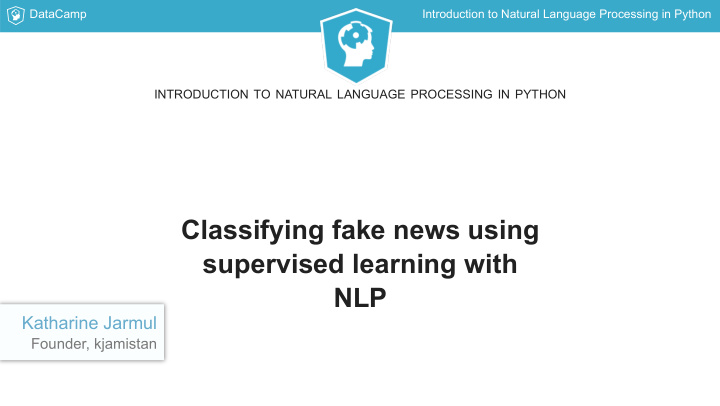



DataCamp Introduction to Natural Language Processing in Python INTRODUCTION TO NATURAL LANGUAGE PROCESSING IN PYTHON Classifying fake news using supervised learning with NLP Katharine Jarmul Founder, kjamistan
DataCamp Introduction to Natural Language Processing in Python What is supervised learning? Form of machine learning Problem has predefined training data This data has a label (or outcome) you want the model to learn Classification problem Goal: Make good hypotheses about the species based on geometric features Sepal Length Sepal Width Petal Length Petal Width Species 5.1 3.5 1.4 0.2 I. setosa 7.0 3.2 4.77 1.4 I.versicolor 6.3 3.3 6.0 2.5 I.virginica
DataCamp Introduction to Natural Language Processing in Python Supervised learning with NLP Need to use language instead of geometric features scikit-learn : Powerful open-source library How to create supervised learning data from text? Use bag-of-words models or tf-idf as features
DataCamp Introduction to Natural Language Processing in Python IMDB Movie Dataset Plot Sci-Fi Action In a post-apocalyptic world in human decay, a ... 1 0 Mohei is a wandering swordsman. He arrives in ... 0 1 #137 is a SCI/FI thriller about a girl, Marla,... 1 0 Goal: Predict movie genre based on plot summary Categorical features generated using preprocessing
DataCamp Introduction to Natural Language Processing in Python Supervised learning steps Collect and preprocess our data Determine a label (Example: Movie genre) Split data into training and test sets Extract features from the text to help predict the label Bag-of-words vector built into scikit-learn Evaluate trained model using the test set
DataCamp Introduction to Natural Language Processing in Python INTRODUCTION TO NATURAL LANGUAGE PROCESSING IN PYTHON Let's practice!
DataCamp Introduction to Natural Language Processing in Python INTRODUCTION TO NATURAL LANGUAGE PROCESSING IN PYTHON Building word count vectors with scikit-learn Katharine Jarmul Founder, kjamistan
DataCamp Introduction to Natural Language Processing in Python Predicting movie genre Dataset consisting of movie plots and corresponding genre Goal: Create bag-of-word vectors for the movie plots Can we predict genre based on the words used in the plot summary?
DataCamp Introduction to Natural Language Processing in Python Count Vectorizer with Python In [1]: import pandas as pd In [2]: from sklearn.model_selection import train_test_split In [3}: from sklearn.feature_extraction.text import CountVectorizer In [4]: df = ... # Load data into DataFrame In [5]: y = df['Sci-Fi'] In [6]: X_train, X_test, y_train, y_test = train_test_split( df['plot'], y, test_size=0.33, random_state=53) In [7]: count_vectorizer = CountVectorizer(stop_words='english') In [8]: count_train = count_vectorizer.fit_transform(X_train.values) In [9]: count_test = count_vectorizer.transform(X_test.values)
DataCamp Introduction to Natural Language Processing in Python INTRODUCTION TO NATURAL LANGUAGE PROCESSING IN PYTHON Let's practice!
DataCamp Introduction to Natural Language Processing in Python INTRODUCTION TO NATURAL LANGUAGE PROCESSING IN PYTHON Training and testing a classification model with scikit-learn Katharine Jarmul Founder, kjamistan
DataCamp Introduction to Natural Language Processing in Python Naive Bayes classifier Naive Bayes Model Commonly used for testing NLP classification problems Basis in probability Given a particular piece of data, how likely is a particular outcome? Examples: If the plot has a spaceship, how likely is it to be sci-fi? Given a spaceship and an alien, how likely now is it sci-fi? Each word from CountVectorizer acts as a feature Naive Bayes: Simple and effective
DataCamp Introduction to Natural Language Processing in Python Naive Bayes with scikit-learn In [10]: from sklearn.naive_bayes import MultinomialNB In [11]: from sklearn import metrics In [12]: nb_classifier = MultinomialNB() In [13]: nb_classifier.fit(count_train, y_train) In [14]: pred = nb_classifier.predict(count_test) In [15]: metrics.accuracy_score(y_test, pred) Out [15]: 0.85841849389820424
DataCamp Introduction to Natural Language Processing in Python Confusion Matrix In [16]: metrics.confusion_matrix(y_test, pred, labels=[0,1]) Out [16]: array([[6410, 563], [ 864, 2242]]) Action Sci-Fi Action 6410 563 Sci-Fi 864 2242
DataCamp Introduction to Natural Language Processing in Python INTRODUCTION TO NATURAL LANGUAGE PROCESSING IN PYTHON Let's practice!
DataCamp Introduction to Natural Language Processing in Python INTRODUCTION TO NATURAL LANGUAGE PROCESSING IN PYTHON Simple NLP, Complex Problems Katharine Jarmul Founder, kjamistan
DataCamp Introduction to Natural Language Processing in Python Translation (source: https://twitter.com/Lupintweets/status/865533182455685121 )
DataCamp Introduction to Natural Language Processing in Python Sentiment Analysis (source: https://nlp.stanford.edu/projects/socialsent/ )
DataCamp Introduction to Natural Language Processing in Python Language Biases (related talk: https://www.youtube.com/watch?v=j7FwpZB1hWc )
DataCamp Introduction to Natural Language Processing in Python INTRODUCTION TO NATURAL LANGUAGE PROCESSING IN PYTHON Let's practice!
Recommend
More recommend